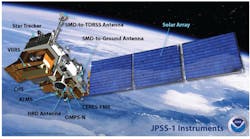UPDATE: JPSS-1 Weather Satellite Boosts Forecasting Accuracy
Update: With the JPSS-1 satellite bus expected to reach completion in the fall, the Clouds and Earth’s Radiant Energy Systems (CERES) instrument recently arrived at Ball Aerospace for integration. The CERES instrument, which will play an integral role in the continuity of long-standing weather and climate measurements, was provided by the Suomo National Polar-Orbiting Partnership mission and built by Northrop Grumman’s Aerospace Systems.
The Ozone Mapping and Profiler Suite (OMPS), built by Ball Aerospace, has passed pre-ship review and is expected to be “shipped in place” soon. The three additional JPSS-1 instruments—a visible/infrared imaging radiometer suite (VIIRS), a cross-track infrared sounder (CrIS), and an advanced technology microwave sounder (ATMS)—are expected to arrive over the next 10 months.
Previously: With the powering on of its primary bus structure, a new satellite has moved closer to its goal of aiding severe-weather predictions. The Joint Polar Satellite System (JPSS-1) will continue the operation currently handled by the Suomi National Polar-Orbiting Partnership (SNPP) satellite. This includes providing data for civil and military weather forecasting, storm tracking, and climate monitoring.
Acquired by the National Oceanic and Atmospheric Administration (NOAA) through NASA, the JPSS-1’s bus structure was built using Ball Aerospace’s Ball Configurable Platform (BCP). Designed for cost-effective remote-sensing applications, the BCP spacecraft family can be customized to accommodate a range of payloads.
For JPSS-1, the payloads include five main remote-sensing instruments: a visible/infrared imaging radiometer suite (VIIRS); cross-track infrared sounder (CrIS); advanced technology microwave sounder (ATMS); ozone mapping and profiler suite (OMPS); and Clouds and the Earth’s Radiant Energy System (CERES).
The Infrared Instruments
The visible/infrared imaging radiometer suite or VIIRS provides images of clouds under sunlit conditions in about a dozen bands. It also offers coverage in a number of infrared bands for night and day cloud-imaging applications. Reportedly, VIIRS merges the radiometric accuracy of an advanced very-high-resolution radiometer (AVHRR) with the high spatial resolution (0.56 km) currently used on the Operational Linescan System [OLS, which is flown on the Defense Meteorological Satellite Program (DMSP)]. This combination enables multiband imaging capabilities, which support high-resolution atmospheric imagery like the visible and infrared imaging of hurricanes and detection of fires, smoke, and atmospheric aerosols. It also can provide accurate measurements of sea surface temperatures by observing the color of the water. VIIRS was recently fully manufactured with all subassemblies fully integrated in preparation for its delivery in 2015. It is now undergoing a two-phase testing process.
The cross-track infrared sounder (CrIS), in contrast, is a high-spectral solution infrared instrument that provides detailed atmospheric temperature and moisture observations. It measures the three-dimensional structure of atmospheric temperatures, water vapor, and trace gases and provides over 1000 infrared spectral channels. The CrIS has improved horizontal and vertical resolution at accuracy approaching 1°K. This helps improve climate prediction for both short-term and long-term weather forecasting.
Adding Detailed Measurements
The advanced technology microwave sounder (ATMS) works in conjunction with the CrIS to provide more details on atmospheric temperature and moisture. It hosts 22 microwave channels from 23 through 183 GHz to provide sounding capabilities. Essentially, it combs the technologies of current-generation microwave temperature and humidity sounders. The combined data from the ATMS and CrIS constructs atmospheric temperature profiles at 1°K accuracy for 1-km layers in the troposphere and moisture profiles accurate to 15% for 2-km layers.
The ozone mapping and profiler suite (OMPS) measures the concentration of ozone in the atmosphere. In doing so, it provides information on how ozone concentration varies with altitude. The data collected builds on data gained from three decades of climate measurements, which were collected as part of a U.S. treaty obligation to monitor global ozone concentrations with no gaps in coverage. This is done through two sensors—a nadir sensor that generates total column ozone measurements and a limb sensor that generates ozone profiles of the along-track limb scattered solar radiance.
For its part, the Clouds and the Earth’s Radiant Energy System (CERES) provides measurements of the space and time distribution of the Earth’s Radiation Budget (ERB). In other words, it details how much energy the Earth gets from the Sun and how much energy it radiates back to outer space as invisible light. With this data, scientists can better understand the links between the ERB and the properties of the atmosphere. Observations also are critical to understanding the effect of clouds on ERB—a major cause of uncertainty when modeling the Earth’s climate.
The Final Product
The primary bus of the satellite and OMPS were completed by Ball Aerospace. The other instruments were developed by Raytheon (VIIRS), ITT Exelis (CrIS), and Northrop Grumman (ATMS and CERES). The bus will be cycled on and off continuously over the next nine months of integration and testing.
Set to launch in early 2017, JPSS-1 will be used by the National Weather Service in models for forecasts three to seven days before a severe weather event. These forecasts will help scientists monitor and predict weather patterns with greater accuracy and speed, giving emergency managers and the public more time to prepare. The overall mission includes the use of the JPSS-1 satellite, the recently launched Total Solar Irradiance (TSI) Calibration Transfer Experiment (TCTE), the currently in-orbit SNPP satellite, and a future JPSS-2 satellite.





